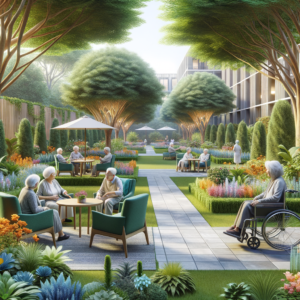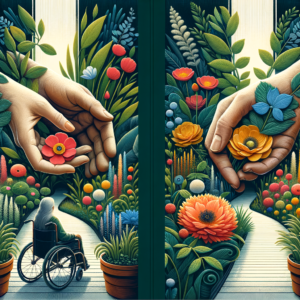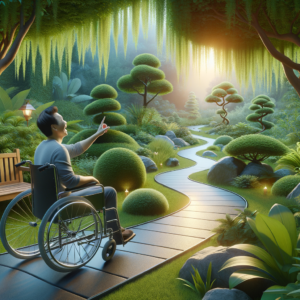Gardening is a rewarding hobby that can bring joy, physical activity, and a sense of accomplishment to seniors. However, as we age, the physical demands of maintaining a garden can become challenging. This comprehensive guide focuses on creating low-maintenance garden designs specifically tailored for seniors, allowing them to continue enjoying the benefits of gardening with less effort and strain.
Benefits of Low-Maintenance Gardening for Seniors
- Reduced Physical Strain: Less demanding tasks protect joints and prevent fatigue
- Time Efficiency: More time to enjoy the garden rather than constantly working in it
- Cost-Effective: Lower water bills and fewer replacements needed
- Stress Reduction: A manageable garden is a source of relaxation, not worry
- Consistent Aesthetics: Maintains an attractive appearance with minimal effort
- Environmental Benefits: Often involves native plants and reduced resource use
Key Principles of Low-Maintenance Garden Design
- Simplicity: Focus on clean lines and uncluttered spaces
- Right Plant, Right Place: Choose plants suited to your climate and conditions
- Grouping: Plant in masses for visual impact and easier care
- Automation: Incorporate systems that reduce manual labor
- Perennial Focus: Emphasize plants that return year after year
- Hardscaping: Use non-living elements to reduce planted areas
- Accessibility: Design with ease of movement and reach in mind
Choosing the Right Plants
Low-Maintenance Plant Characteristics:
- Drought-tolerant
- Disease and pest-resistant
- Long-blooming or with attractive foliage year-round
- Slow-growing or naturally compact
Recommended Low-Maintenance Plants:
- Shrubs: Boxwood, Hydrangea, Spirea
- Perennials: Daylilies, Coneflowers, Sedum
- Grasses: Feather Reed Grass, Blue Fescue
- Ground Covers: Creeping Thyme, Lamb’s Ear
- Native Plants: Specific to your region for optimal adaptation
Efficient Watering Systems
- Drip Irrigation: Delivers water directly to plant roots
- Soaker Hoses: Ideal for garden beds and borders
- Smart Sprinkler Systems: Adjust based on weather conditions
- Self-Watering Containers: Reduce the frequency of watering
- Rain Barrels: Collect rainwater for garden use
Mulching and Weed Control
- Organic Mulch: Apply 2-3 inches to suppress weeds and retain moisture
- Landscape Fabric: Use under mulch for added weed prevention
- Groundcovers: Plant low-growing species to naturally suppress weeds
- Raised Beds: Easier to maintain and can reduce weed infiltration
- Regular Maintenance: Address weeds when small for easier removal
Hardscaping Elements for Reduced Maintenance
- Patios: Create usable space with minimal upkeep
- Gravel Paths: Provide drainage and reduce muddy areas
- Decorative Rocks: Use in place of high-maintenance planted areas
- Retaining Walls: Control erosion and create level planting areas
- Water Features: Choose low-maintenance options like bubbling rocks
Container Gardening for Ease and Accessibility
- Elevated Planters: Reduce bending and stooping
- Large Containers: Require less frequent watering
- Lightweight Materials: Choose fiber clay or resin for easier movement
- Self-Watering Containers: Extend time between watering
- Grouping: Cluster containers for efficient watering and visual impact
Vertical Gardening Solutions
- Wall-Mounted Planters: Bring plants to an accessible height
- Trellises: Support vines and climbing plants
- Living Walls: Create lush greenery with minimal ground space
- Hanging Baskets: Add color at eye level
- Tiered Planters: Maximize space and add dimension
Lawn Alternatives
- Clover: Low-growing, requires less mowing
- Ornamental Grasses: Create texture with minimal care
- Artificial Turf: Eliminates mowing and watering needs
- Gravel or Pebble Gardens: Pair with drought-tolerant plants
- Moss Gardens: For shady areas, requires minimal maintenance
Tools and Equipment for Easier Gardening
- Ergonomic Hand Tools: Reduce strain on hands and wrists
- Long-Handled Tools: Minimize bending and reaching
- Garden Scoot: A rolling seat for comfortable ground-level work
- Lightweight Hoses: Easier to maneuver for watering
- Electric or Battery-Powered Tools: Lighter and easier to operate than gas-powered options
Seasonal Maintenance Tips
Spring:
- Apply fresh mulch
- Prune summer-blooming shrubs
- Plant new perennials and annuals
Summer:
- Deadhead flowers to encourage blooming
- Monitor for pests and diseases
- Maintain consistent watering
Fall:
- Plant spring-blooming bulbs
- Cut back perennials after first frost
- Clean and store garden tools
Winter:
- Plan for next season
- Maintain winter interest with evergreens and ornamental grasses
- Protect sensitive plants from frost
Incorporating Wildlife-Friendly Features
- Bird Baths: Provide water for birds and visual interest
- Native Plant Varieties: Attract local pollinators
- Berry-Producing Shrubs: Food source for birds
- Butterfly Gardens: Plant nectar-rich flowers
- Bee Hotels: Support solitary bees with minimal maintenance
Conclusion
Creating a low-maintenance garden allows seniors to continue enjoying the pleasures of gardening without overwhelming physical demands. By incorporating efficient design principles, choosing the right plants, and utilizing labor-saving techniques and tools, it’s possible to create a beautiful, manageable outdoor space that provides joy and relaxation for years to come.
Remember, the goal of a low-maintenance garden is not to eliminate all work, but to create a space that can be cared for easily and enjoyed fully. With thoughtful planning and design, seniors can create outdoor sanctuaries that nourish the body, mind, and spirit without excessive physical strain or time commitment.
FAQ
- Q: How often do I need to water a low-maintenance garden? A: It depends on your plant selection and climate, but generally, established low-maintenance gardens might need watering once a week or less, especially if you’ve incorporated efficient irrigation systems.
- Q: Can I have a colorful garden that’s still low-maintenance? A: Absolutely! Choose long-blooming perennials, shrubs with colorful foliage, and incorporate hardscaping elements like colorful pots or garden art for year-round interest.
- Q: What’s the easiest way to control weeds in a low-maintenance garden? A: A combination of mulching, using landscape fabric, and planting ground covers can significantly reduce weed growth. Regular but brief weeding sessions can prevent weeds from becoming established.
- Q: Are there any vegetables that are particularly easy to grow for seniors? A: Yes, consider cherry tomatoes, bush beans, lettuce, and herbs like basil and chives. These can be grown in raised beds or containers for easier access.
- Q: How can I make my existing garden more low-maintenance? A: Start by replacing high-maintenance plants with hardier varieties, improve your soil with compost to promote plant health, install an irrigation system, and increase hardscaping elements to reduce planted areas requiring care.



